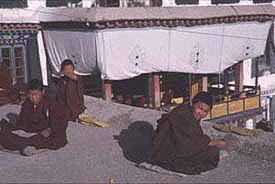 Buddhists may have led scientists to the secret of happiness.
Buddhists may have led scientists to the secret of happiness.
BUDDHISTS LEAD SCIENTISTS TO 'SEAT OF HAPPINESS'
Ananova
 Buddhists may have led scientists to the secret of happiness.
Buddhists may have led scientists to the secret of happiness.
Research in the US suggests it lies just behind the forehead in the brain's left prefrontal lobes.
Scientists have found that in experienced, practising Buddhists, this part of the brain is consistently "lit up".
Persistent activity of the left prefrontal lobes is associated with positive emotions and good moods.
The preliminary findings emerged from research led by Richard Davidson, at the Laboratory for Affective Neuroscience at the University of Wisconsin at Madison.
Owen Flanagan, Professor of Philosophy at Duke University in North Carolina, said: "We can now hypothesise with some confidence that those apparently happy, calm Buddhist souls one regularly comes across in places such as Dharamsala, India -- the Dalai Lama's home -- really are happy.
"Behind those calm exteriors lie persistently frisky left prefrontal lobes. If these findings are widely confirmed, they will be of great importance."
He said it was likely that there was something about Buddhist practice that produced happiness.
------------
MEDITATION SHOWN TO LIGHT UP BRAINS OF BUDDHISTS
Reuters
May 21, 2003
http://story.news.yahoo.com/news...
LONDON (Reuters) - Buddhists really are happy, calm and serene people -- at least according to their brain scans.
Using new scanning techniques, neuroscientists have discovered that certain areas of the brain light up constantly in Buddhists, which indicates positive emotions and good mood. This happens at times even when they are not meditating.
"We can now hypothesize with some confidence that those apparently happy, calm Buddhist souls one regularly comes across in places such as Dharamsala, India, really are happy," Professor Owen Flanagan, of Duke University in North Carolina, said Wednesday.
Dharamsala is the home base of exiled Tibetan leader the Dalai Lama.
The scanning studies by scientists at the University of Wisconsin at Madison showed activity in the left prefrontal lobes of experienced Buddhist practitioners. The area is linked to positive emotions, self-control and temperament.
Other research by Paul Ekman, of the University of California San Francisco Medical Center, suggests that meditation and mindfulness can tame the amygdala, an area of the brain which is the hub of fear memory.
Ekman discovered that experienced Buddhists were less likely to be shocked, flustered, surprised or as angry as other people.
Flanagan believes that if the findings of the studies can be confirmed they could be of major importance.
"The most reasonable hypothesis is that there is something about conscientious Buddhist practice that results in the kind of happiness we all seek," Flanagan said in a report in New Scientist magazine.